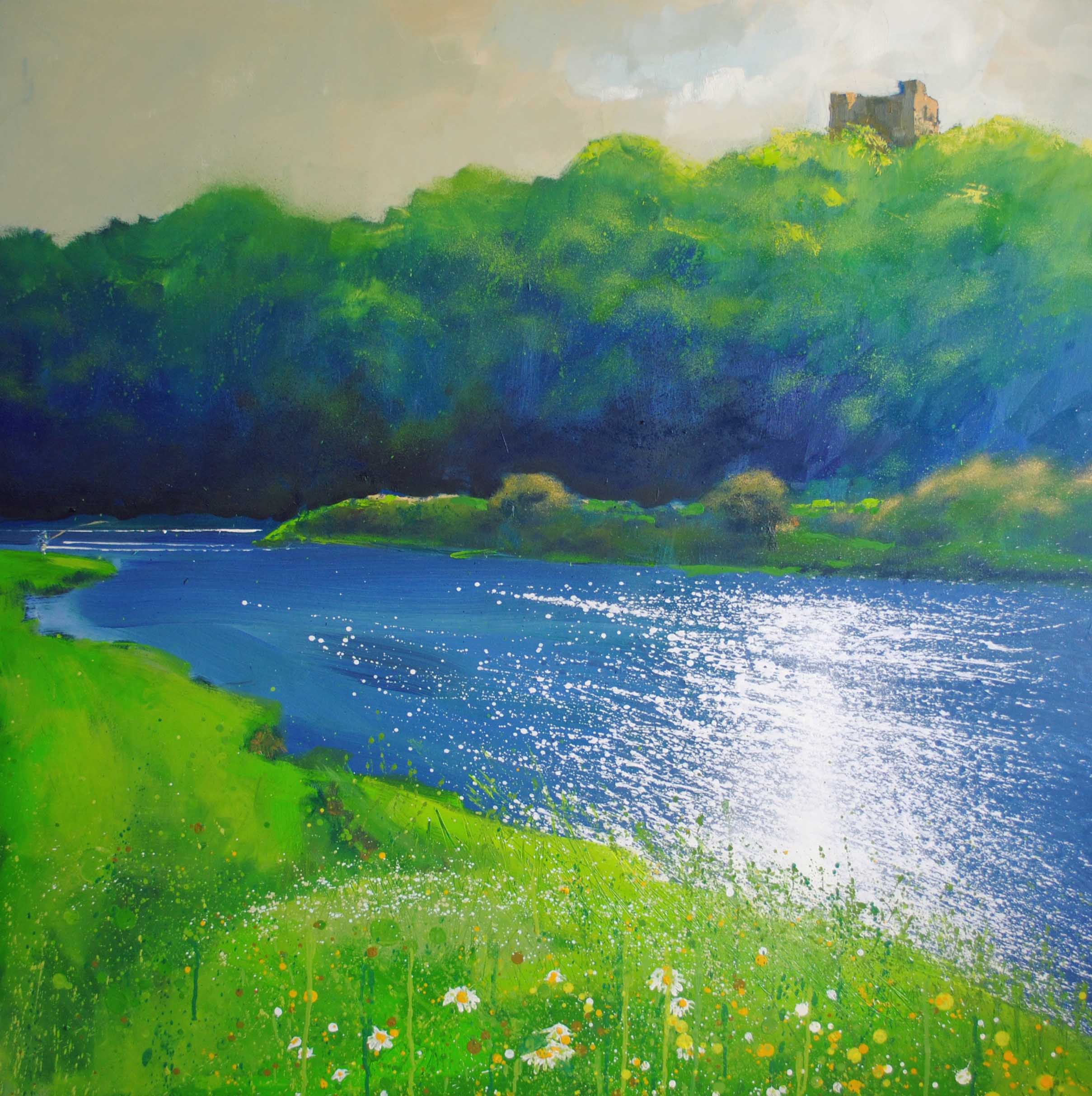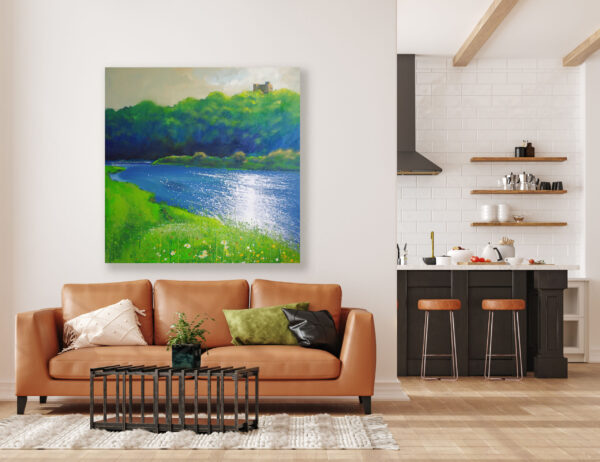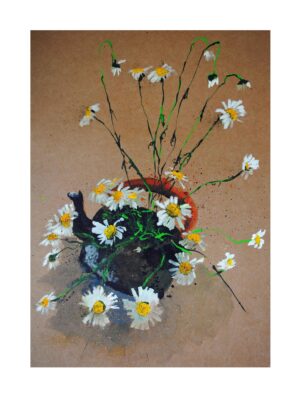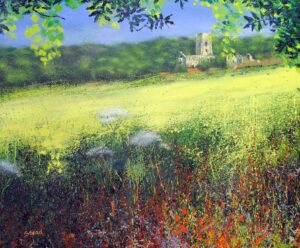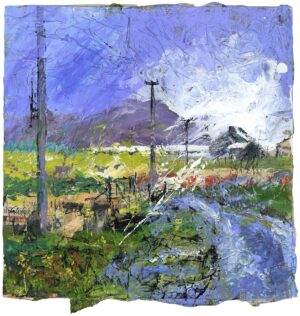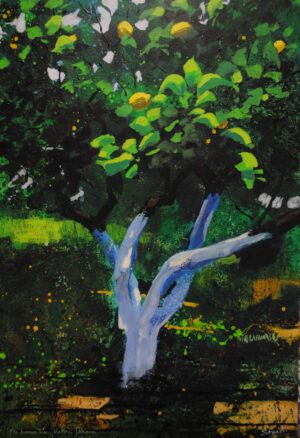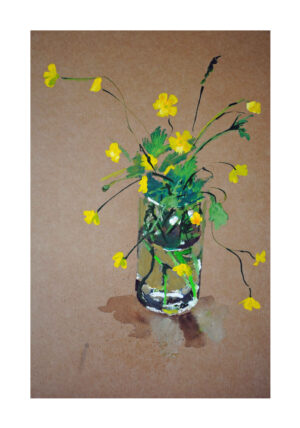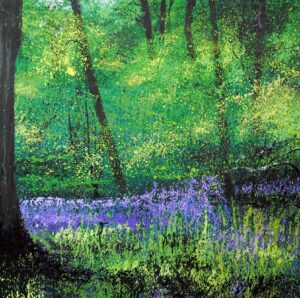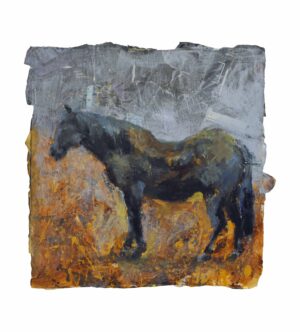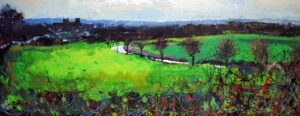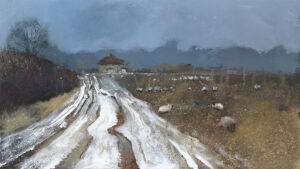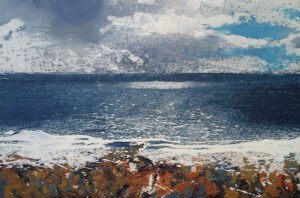Norham Castle
Original Sold
- Title: Norham Castle
- Medium: Oil
- Substrate: 10oz cotton canvas
- Size: 100cm x 100cm
- Style: Contemporary
- Frame: Yes
- Print available: Yes
David had never visited Norham Castle until he was asked to take part in a film for European ARTE tv focussing on JMW Turner’s 1797 tour of the North of England. The film, part of a series called Vistas Of Longing, was to follow Turner’s journey from Harewood House nr Harrogate to the Scottish Boarders and Norham Castle where David would make a painting of the subject famously painted by Turner.
Sadly, the film (link above) never really reached its potential and turned into more of a travelogue but several pictures were made and foremost amongst them is Norham Castle.
Turner himself visited Norham at least three times – he returned in 1831 and on passing the castle in a coach he removed his hat and took a bow, at this his travelling companion, the publisher Robert Cadell, enquired as to the meaning of the gesture: ‘Oh’, was the reply, ‘I made a drawing or painting of Norham several years since. It took, and from that day to this and from that day to this I have had as much to do as my hands could execute’.
David says: It took some time to find the ideal spot from which to paint: Turner had painted from the English bank of the river Tweed but the view today is obscured by trees so I ended up on the Scottish side which not only gave a clearer view, but also allowed for increased drama with the glittering light on the foreground river.
Whilst this large oil was painted in the studio, I made several studies on the riverbank in pencil, watercolour and acrylic. It was a challenging day to paint outside with strong winds, occassional squalls of rain and fast changing light but often, overcoming these difficulties can add to the life of the finished paintings: blades of grass, seeds, insects etc become stuck to the surface and I often use the water available – in this case the river Tweed – to dilute my paints. Speed is of the essence too – you have to be quick to capture a scene as clouds race overhead obscuring the sun.
J.M.W. Turner’s engagement with Norham Castle stands as a testament to his profound connection with the landscapes of northern England. His depictions of this medieval fortress, particularly the renowned “Norham Castle, Sunrise” (c.1845), encapsulate his innovative approach to capturing light and atmosphere. The documentary “Vistas of Longing – Painters and Their Landscapes” delves into the landscapes that inspired Turner, shedding light on his artistic journey.
Turner’s initial encounter with Norham Castle occurred during his 1797 tour of northern England. This journey proved pivotal, as the castle’s imposing presence and its strategic position overlooking the River Tweed left a lasting impression on the young artist. The resulting watercolour, “Norham Castle on the Tweed, Sunrise,” exhibited at the Royal Academy in 1798, was met with critical acclaim, marking a significant milestone in Turner’s burgeoning career. This early success not only established his reputation but also underscored his ability to convey the transient effects of light and weather—a theme that would pervade his later works.
Throughout his career, Turner revisited Norham Castle, both physically and artistically. His repeated portrayals of the site, spanning from detailed early watercolours to more abstract late oil paintings, reflect his evolving style and deepening preoccupation with light and colour. The culmination of this exploration is evident in “Norham Castle, Sunrise” (c.1845), housed in Tate Britain. In this work, the solid structure of the castle dissolves into a luminous haze, demonstrating Turner’s shift towards a more atmospheric and expressive representation of the landscape.
The documentary “Vistas of Longing – Painters and Their Landscapes” featuring David Stead, offers insight into the environments that shaped Turner’s artistic vision. By exploring the diverse terrains of northern England—from the rolling hills of Yorkshire to the rugged east coast—the film contextualizes Turner’s inspiration and his profound connection to these locales. It emphasizes how the dramatic landscapes of the North, with their unique interplay of light and shadow, were instrumental in Turner’s development as a landscape painter. The film also highlights Turner’s 1797 tour as a transformative period, during which he discovered subjects that would become central to his oeuvre.
Turner’s fascination with Norham Castle can be attributed to several factors. The castle’s historical significance and its picturesque decay offered a rich tapestry for exploration. Moreover, its location on the Anglo-Scottish border, perched above the River Tweed, provided a dynamic setting where the interplay of light, water, and architecture could be observed and rendered. This setting allowed Turner to experiment with the effects of dawn and dusk, capturing the ephemeral qualities of light that became a hallmark of his work.
In his later years, Turner’s representations of Norham Castle became increasingly abstract, focusing more on the atmospheric conditions than on topographical accuracy. This evolution mirrors his broader artistic trajectory, as he moved away from detailed representations towards a more impressionistic and expressive style. “Norham Castle, Sunrise” exemplifies this shift, with the castle bathed in a golden glow, almost merging with the surrounding landscape. This approach not only challenged contemporary artistic conventions but also paved the way for future movements that prioritized the subjective experience of the artist.
The enduring legacy of Turner’s Norham Castle series lies in its demonstration of his ability to transcend mere representation. Through these works, he captured the essence of a place, its atmosphere, and its transient beauty. The documentary “Vistas of Longing” underscores this achievement by situating Turner’s art within the landscapes that inspired him, offering viewers a deeper appreciation of his genius and the environments that fueled his creativity.
In conclusion, J.M.W. Turner’s depictions of Norham Castle are more than mere landscapes; they are studies in light, atmosphere, and the passage of time. His repeated engagement with this subject reflects a lifelong fascination and serves as a testament to his innovative spirit. The film “Vistas of Longing” enriches our understanding of this relationship, highlighting the profound impact of northern England’s landscapes on one of Britain’s greatest artists.

